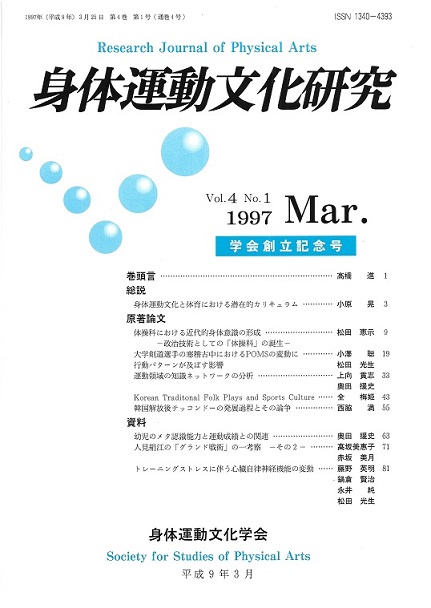Volume 4, Issue 1
Displaying 1-10 of 10 articles from this issue
- |<
- <
- 1
- >
- >|
Publication Note
-
1997Volume 4Issue 1 Pages 1
Published: March 31, 1997
Released on J-STAGE: March 31, 2022
Download PDF (1142K)
Review
-
1997Volume 4Issue 1 Pages 3-7
Published: March 31, 1997
Released on J-STAGE: March 31, 2022
Download PDF (7596K)
Original investigations
-
1997Volume 4Issue 1 Pages 9-18
Published: March 31, 1997
Released on J-STAGE: March 31, 2022
Download PDF (16924K) -
1997Volume 4Issue 1 Pages 19-31
Published: March 31, 1997
Released on J-STAGE: March 31, 2022
Download PDF (16698K) -
1997Volume 4Issue 1 Pages 33-41
Published: March 31, 1997
Released on J-STAGE: March 31, 2022
Download PDF (11808K) -
1997Volume 4Issue 1 Pages 43-53
Published: March 31, 1997
Released on J-STAGE: March 31, 2022
Download PDF (12991K) -
1997Volume 4Issue 1 Pages 55-62
Published: March 31, 1997
Released on J-STAGE: March 31, 2022
Download PDF (11883K)
Materials
-
1997Volume 4Issue 1 Pages 63-70
Published: March 31, 1997
Released on J-STAGE: March 31, 2022
Download PDF (10305K) -
1997Volume 4Issue 1 Pages 71-80
Published: March 31, 1997
Released on J-STAGE: March 31, 2022
Download PDF (14035K) -
1997Volume 4Issue 1 Pages 81-88
Published: March 31, 1997
Released on J-STAGE: March 31, 2022
Download PDF (10382K)
- |<
- <
- 1
- >
- >|
